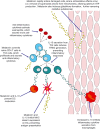Melatonin--a pleiotropic molecule involved in pathophysiological processes following organ transplantation
- PMID: 19604298
- PMCID: PMC2729521
- DOI: 10.1111/j.1365-2567.2009.03113.x
Melatonin--a pleiotropic molecule involved in pathophysiological processes following organ transplantation
Abstract
Mammals adjust their physiology in response to seasonal changes to environment (i.e. photoperiod, temperature, food availability). These changes are thought to predominantly occur for the conservation of energy during winter, by pervasive changes such as the inhibition of reproduction. Previous reports have suggested that circannual changes also occur to the immune system. In mammals, this chronological effect may be dependent on photoperiod, and evidence exists to suggest that there is a great deal of immune variation in response to light, or circadian rhythm. This is a clinically relevant, yet under-reported area of human transplantation. The aim of this review is to discuss immune variation, with specific emphasis on melatonin secretion, in the context of organ rejection, infection, neoplasia formation, and immunosuppression.
Figures


References
-
- Moore RY. Circadian rhythms: basic neurobiology and clinical applications. Annu Rev Med. 1997;48:253–66. - PubMed
-
- Claustrat B, Brun J, Chazot G. The basic physiology and pathophysiology of melatonin. Sleep Med Rev. 2005;9:11–24. - PubMed
-
- Maestroni GJ, Conti A, Pierpaoli W. Role of the pineal gland in immunity. Circadian synthesis and release of melatonin modulates the antibody response and antagonizes the immunosuppressive effect of corticosterone. J Neuroimmunol. 1986;13:19–30. - PubMed
-
- Carrillo-Vico A, Guerrero JM, Lardone PJ, Reiter RJ. A review of the multiple actions of melatonin on the immune system. Endocrine. 2005;27:189–200. - PubMed
Publication types
MeSH terms
Substances
LinkOut - more resources
Full Text Sources
Medical

